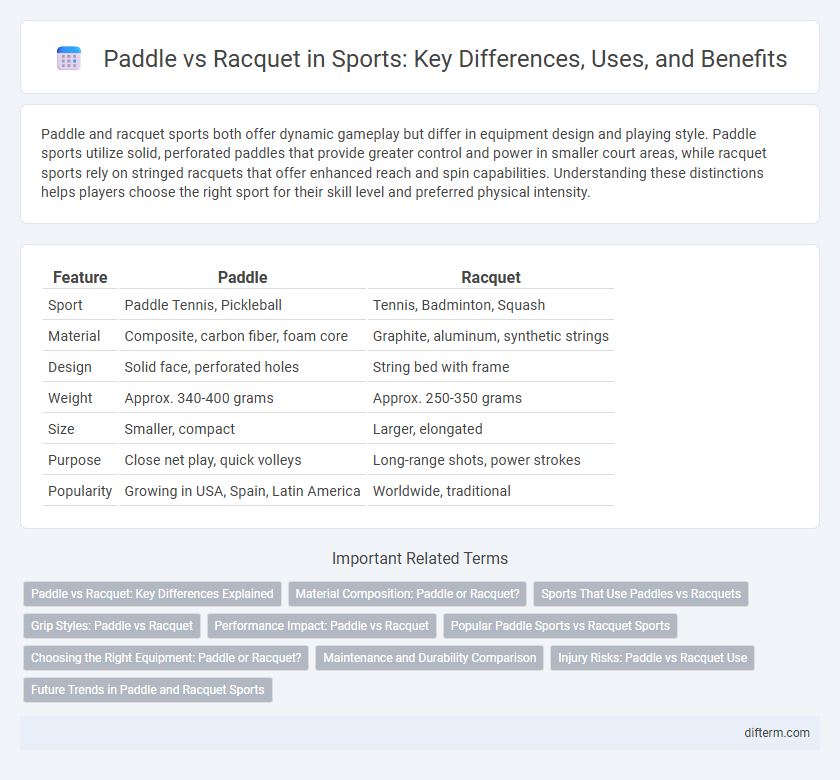Paddle and racquet sports both offer dynamic gameplay but differ in equipment design and playing style. Paddle sports utilize solid, perforated paddles that provide greater control and power in smaller court areas, while racquet sports rely on stringed racquets that offer enhanced reach and spin capabilities. Understanding these distinctions helps players choose the right sport for their skill level and preferred physical intensity.
Table of Comparison
| Feature | Paddle | Racquet |
|---|---|---|
| Sport | Paddle Tennis, Pickleball | Tennis, Badminton, Squash |
| Material | Composite, carbon fiber, foam core | Graphite, aluminum, synthetic strings |
| Design | Solid face, perforated holes | String bed with frame |
| Weight | Approx. 340-400 grams | Approx. 250-350 grams |
| Size | Smaller, compact | Larger, elongated |
| Purpose | Close net play, quick volleys | Long-range shots, power strokes |
| Popularity | Growing in USA, Spain, Latin America | Worldwide, traditional |
Paddle vs Racquet: Key Differences Explained
Paddle and racquet differ primarily in design and playing style; paddles have solid, perforated surfaces without strings, while racquets feature a strung hitting area. Paddle sports, such as paddle tennis, typically use smaller courts and emphasize control and placement, whereas racquet sports like tennis demand more power and spin. Understanding these distinctions helps players choose the appropriate equipment tailored to their athletic needs and preferred gameplay.
Material Composition: Paddle or Racquet?
Paddle rackets are primarily made from composite materials such as carbon fiber, fiberglass, and sometimes foam cores, offering a lightweight yet durable structure ideal for quick maneuverability. Traditional racquets often feature a frame composed of graphite, aluminum, or titanium, combined with synthetic strings that provide flexibility and power. The material composition directly influences the weight, strength, and playing style suitability between paddles and racquets.
Sports That Use Paddles vs Racquets
Sports that use paddles, such as table tennis, pickleball, and paddleboarding, rely on solid, flat implements designed to strike lightweight balls or propel watercraft. In contrast, racquet sports like tennis, badminton, and squash utilize stringed frames to hit balls or shuttlecocks with greater control and power. The primary distinction lies in the equipment's design, influencing gameplay speed, precision, and physical demands unique to each sport.
Grip Styles: Paddle vs Racquet
Paddle grip styles typically emphasize a continental or hammer grip, allowing for quick wrist movements and better control in close-quarters play, essential for sports like pickleball and paddle tennis. Racquet grip styles vary more widely, including eastern, semi-western, and western grips, each optimized for different spin and power combinations in tennis and badminton. Understanding these grip differences can significantly impact shot precision, stroke versatility, and overall performance in competitive paddle and racquet sports.
Performance Impact: Paddle vs Racquet
Paddle sports emphasize control and precision due to the solid surface and shorter handle, enhancing maneuverability and quick reaction times during play. In contrast, racquet sports benefit from string tension and larger hitting areas, providing greater power and shot variety, which significantly influences player performance. Ultimately, the choice between paddle and racquet directly impacts gameplay strategy, shot execution, and overall effectiveness on the court.
Popular Paddle Sports vs Racquet Sports
Paddle sports like pickleball, paddle tennis, and platform tennis have surged in popularity due to their accessibility and smaller court sizes, appealing to a broad age range and skill level. Racquet sports such as tennis, badminton, and squash maintain a strong global presence with established professional circuits and higher physical intensity. The choice between paddle and racquet sports hinges on factors like court dimensions, equipment design, and game speed, influencing player preference and regional popularity trends.
Choosing the Right Equipment: Paddle or Racquet?
Selecting the right equipment in sports depends on the playing style and specific game rules associated with paddle or racquet sports. Paddle sports generally require a solid, perforated paddle that offers control and power, ideal for sports like pickleball or padel. Racquet sports demand a stringed racquet designed for faster swings and precision, commonly used in tennis and badminton, influencing player performance based on grip, weight, and string tension.
Maintenance and Durability Comparison
Paddle sports equipment generally requires less maintenance compared to racquets due to their solid, one-piece design which reduces the risk of frame damage and string wear. Racquet strings need regular restringing every 3-6 months depending on play frequency, while paddles only require occasional surface cleaning to maintain grip and performance. Durability-wise, paddles made from composite materials tend to endure impacts better, whereas racquets demand more careful handling to prevent frame cracks and string breakage.
Injury Risks: Paddle vs Racquet Use
Paddle sports generally pose a lower risk of wrist and elbow injuries compared to racquet sports due to the lighter weight and smaller surface area of paddles, which reduce strain during play. Racquet use often leads to a higher incidence of repetitive stress injuries such as tennis elbow and rotator cuff tendinitis because of the increased force and extended reach required. Proper technique and equipment adjustment are critical in both sports to minimize injury risks and enhance player safety.
Future Trends in Paddle and Racquet Sports
Advancements in materials such as carbon fiber and graphene are driving enhanced durability and performance in both paddle and racquet sports equipment. Emerging technologies, including smart sensors and AI-driven analytics, are transforming training methods and player performance optimization. Growing global participation and increased investment in e-sports paddle and racquet simulations hint at a digitally integrated future for these sports.
paddle vs racquet Infographic

 difterm.com
difterm.com